|
December 1961 Popular Electronics
 Table of Contents Table of Contents
Wax nostalgic about and learn from the history of early electronics. See articles
from
Popular Electronics,
published October 1954 - April 1985. All copyrights are hereby acknowledged.
|
Popular Electronics
magazine's quizmeister Robert P. Balin created this "Voltage Quiz" for the
December 1961 issue. Fortunately, only fixed resistors (6 Ω each) and battery voltage source(s)
are involved. The goal is to calculate the voltage at point "A" with respect to ground. Analyzing some of the circuits is made easier by
rearranging the layout to remove wiring overlaps. Circuit 5 might be the
simplest of all, and can be done fairly easily in your head. Others, like
circuit 1, are best approached by writing two mesh equations per
Kirchhoff's voltage law (the sum
of all voltages in a closed circuit equals zero) and solving the resulting two
equations in two unknowns (basic algebra). Spoiler: Upon redrawing a couple
circuits you might discover an identical instance of a previous one, making the
solution the same as well. A big list of other quizzes is given below.
Voltage Quiz
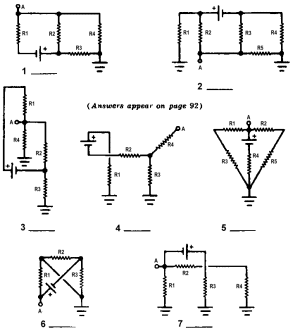 By Robert P. Balin By Robert P. Balin
Can you determine the voltage and polarity of point A with respect to ground
in each of the seven circuits shown below? All resistors measure six ohms and each
battery produces six volts d.c. You'll find it helpful to use pencil and paper in
working out the problems. Write the answers in the spaces provided under the diagrams.
***
Quizzes from vintage electronics magazines such as Popular
Electronics, Electronics-World, QST, and Radio News
were published over the years - some really simple and others not so simple. Robert P. Balin
created most of the quizzes for Popular Electronics. This is a listing
of all I have posted thus far.
- RF Cafe Quiz #71:
Tech Headlines for Week of 3/13/2023
- RF Cafe Quiz #70:
Analog &
RF Filter Basics
- RF Cafe Quiz #69:
RF
Electronics Basics
- RF Cafe Quiz #68:
RF & Analog Company Mergers & Acquisitions in 2017
- RF Cafe Quiz #67:
RF & Microwave Company Name Change History
- RF Cafe Quiz #66:
Spectrum and Network Measurements
- RF Cafe Quiz #65:
Troubleshooting & Repairing Commercial Electrical Equipment
- RF Cafe Quiz #64:
Space-Time Adaptive Processing for Radar
- RF Cafe Quiz #63:
Envelope Tracking Power Amplifiers
- RF Cafe Quiz #62:
Stimson's Introduction to Airborne Radar
- RF Cafe Quiz #61:
Practical Microwave Circuits
- RF Cafe Quiz #60:
Ten Essential Skills for Electrical Engineers
- RF Cafe Quiz #59:
Microwave Circulator Design
- RF Cafe Quiz #58:
Microwave and Millimeter-Wave Electronic Packaging
- RF Cafe Quiz #57:
Frequency-Agile Antennas for Wireless Communications
- RF Cafe Quiz #56:
Tube Testers
and Electron Tube Equipment
- RF Cafe Quiz #55:
Conquer
Radio Frequency
- RF Cafe Quiz #54:
Microwave Mixer Technology and Applications
- RF Cafe Quiz #53:
Chipless RFID Reader Architecture
- RF Cafe Quiz #52:
RF and Microwave Power Amplifiers
- RF Cafe Quiz #51:
Antennas and Site Engineering for Mobile Radio Networks
- RF Cafe Quiz #50:
Microstrip Lines and Slotlines
- RF Cafe Quiz #49:
High-Frequency Integrated Circuits
- RF Cafe Quiz #48:
Introduction to Infrared and Electro-Optical Systems
- RF Cafe Quiz #47:
LCP for Microwave Packages and Modules
- RF Cafe Quiz #46:
RF, Microwave, and Millimeter-Wave Components
- RF Cafe Quiz #45:
Dielectric and Thermal Properties of Materials at Microwave Frequencies
- RF Cafe Quiz #44:
Monopulse Principles and Techniques
- RF Cafe Quiz #43:
Plasma Antennas
- RF Cafe Quiz #42: The Micro-Doppler
Effect in Radar
- RF Cafe Quiz #41: Introduction
to RF Design Using EM Simulators
- RF Cafe Quiz #40: Introduction
to Antenna Analysis Using EM Simulation
- RF Cafe Quiz #39: Emerging
Wireless Technologies and the Future Mobile Internet
- RF Cafe Quiz #38: Klystrons,
Traveling Wave Tubes, Magnetrons, Crossed-Field Amplifiers, and Gyrotrons
- RF Cafe Quiz #37: Component
Reliability for Electronic Systems
- RF Cafe Quiz #36: Advanced
RF MEMS
- RF Cafe Quiz #35: Frequency
Synthesizers: Concept to Product
- RF Cafe Quiz #34: Multi-Gigabit
Microwave and Millimeter-Wave Wireless Communications
- RF Cafe Quiz #33: Battlespace
Technologies: Network-Enabled Information Dominance
- RF Cafe Quiz #32: Modern Communications
Receiver Design and Technology
- RF Cafe Quiz #31: Quantum
Mechanics of Nanostructures
- RF Cafe Quiz #30: OFDMA System
Analysis and Design
- RF Cafe Quiz #29: Cognitive
Radar
- RF Cafe Quiz #28: Human-Centered
Information Fusion
- RF Cafe Quiz #27: Remarkable
Engineers
- RF Cafe Quiz #26: Substrate
Noise Coupling in Analog/RF Circuits
- RF Cafe Quiz #25: Component
Reliability for Electronic Systems
- RF Cafe Quiz #24: Ultra Low
Power Bioelectronics
- RF Cafe Quiz #23: Digital
Communications Basics
- RF Cafe Quiz #22: Remember
the Basics?
- RF Cafe Quiz #21: Wireless
Standards Knowledge
- RF Cafe Quiz #20: Famous First
Names
- RF Cafe Quiz #19: Basic Circuit
Theory
- RF Cafe Quiz #18: Archaic
Scientific Words & Definitions
- RF Cafe Quiz #17: Inventors &
Their Inventions
- RF Cafe Quiz #16: Antennas
- RF Cafe Quiz #15: Numerical
Constants
- RF Cafe Quiz #14: Oscillators
- RF Cafe Quiz #13: General
Knowledge
- RF Cafe Quiz #12: Electronics
Corporations Headquarters
- RF Cafe Quiz #11: Famous Inventors &
Scientists
- RF Cafe Quiz #10: A Sampling
of RF & Wireless Topics
- RF Cafe Quiz #9: A Smorgasbord
of RF Topics
- RF Cafe Quiz #8: Hallmark Decades
in Electronics
- RF Cafe Quiz #7: Radar Fundamentals
- RF Cafe Quiz #6: Wireless Communications
Fundamentals
- RF Cafe Quiz #5: Company Logo
Recognition
- RF Cafe Quiz #4: General RF
Topics
- RF Cafe Quiz #3: General RF/Microwave
Topics
- RF Cafe Quiz #2: General RF
Topics
- RF Cafe Quiz #1: General RF
Knowledge
- Vacuum Tube Quiz,
February 1961 Popular Electronics
- Kool-Keeping Kwiz, June
1970 Popular Electronics
- Find the Brightest
Bulb Quiz, April 1960 Popular Electronics
-
Where Do the Scientists Belong? - Feb 19, 1949 Saturday Evening Post
|
-
What's Your EQ? - April 1967 Radio-Electronics
-
What's Your EQ? -
March 1967 Radio-Electronics
-
What's Your EQ? - December 1964 Radio-Electronics
-
What's Your EQ? - January 1967 Radio-Electronics
-
Wanted: 50,000 Engineers - January 1953 Popular Mechanics
-
What's Your EQ? - August 1964 Radio-Electronics
- Voltage Quiz
- December 1961 Popular Electronics
-
What is It? - June 1941 Popular Science
- What Do You Know
About Resistors? - April 1974 Popular Electronics
-
What's Your EQ? - September 1963 Radio-Electronics
- Potentiometer Quiz - September
1962 Popular Electronics
-
Mathematical Bafflers - March 1965 Mechanix Illustrated
- Op Amp Quiz -
October 1968 Popular Electronics
- Electronic "A"
Quiz - April 1968 Popular Electronics
-
What's Your EQ? - May 1961 Radio-Electronics
-
Popular Science Question Bee - February 1939 Popular Science
-
What is It? - A Question Bee in Photographs - June 1941 Popular Science
-
What's Your EQ? - June 1961 Radio-Electronics
-
What's Your EQ? - June 1964 Radio-Electronics
-
What's Your EQ? - May 1964 Radio-Electronics
-
What's Your EQ? - August 1963 Radio-Electronics
-
What's Your EQ? - May 1963 Radio-Electronics
- Bridge
Function Quiz - September 1969 Radio-Electronics
-
What's Your EQ? - March 1963 Radio-Electronics
-
What's Your EQ? - February 1967 Radio-Electronics
-
Circuit Quiz - June 1966 Radio-Electronics
-
What's Your EQ? - June 1966 Radio-Electronics
- Electronics
Mathematics Quiz - June 1969 Popular Electronics
- Brightest
Light Quiz - April 1964 Popular Electronics
-
What's Your EQ? - April 1963 Radio-Electronics
- Electronics "B" Quiz
- July 1969 Popular Electronics
- Ohm's Law Quiz
- March 1969 Popular Electronics
-
Antenna Quiz - November 1962 Electronics World
- Color Code Quiz
- November 1967 Popular Electronics
- CapaciQuiz
- August 1961 Popular Electronics
- Transformer
Winding Quiz - December 1964 Popular Electronics
-
Audiophile Quiz - November 1957 Radio-electronics
- Capacitor
Function Quiz - March 1962 Popular Electronics
- Greek Alphabet
Quiz - December 1963 Popular Electronics
- Circuit
Designer's Name Quiz - July 19680 Popular Electronics
-
Sawtooth Sticklers Quiz - November 1960 Radio-Electronics
-
Elementary
Radio Quiz - December 1947 Radio-Craft
- Hi-Fi
Quiz - October 1955 Radio & Television News
- Electronics Physics
Quiz - March 1974 Popular Electronics
- A Baffling Quiz
- January 1968 Popular Electronics
- Electronics IQ
Quiz - May 1967 Popular Electronics
- Plug and Jack
Quiz - December 1967 Popular Electronics
- Electronic
Switching Quiz - October 1967 Popular Electronics
- Electronic
Angle Quiz - September 1967 Popular Electronics
- International
Electronics Quiz - July 1967 Popular Electronics
- FM Radio
Quiz - April 1950 Radio & Television News
- Bridge Circuit
Quiz -December 1966 Popular Electronics
- Diode Function
Quiz - August 1965 Popular Electronics
- Diagram Quiz,
August 1966 Popular Electronics
- Quist Quiz - November
1953 QST
- TV Trouble Quiz,
July 1966 Popular Electronics
- Electronics History Quiz,
December 1965 Popular Electronics
- Scope-Trace Quiz,
March 1965 Popular Electronics
-
Electronic
Circuit Analogy Quiz, April 1973
-
Test Your Knowledge of Semiconductors, August 1972 Popular Electronics
- Ganged Switching
Quiz, April 1972 Popular Electronics
- Lamp Brightness
Quiz, January 1969 Popular Electronics
- Lissajous
Pattern Quiz, September 1963 Popular Electronics
- Electronic
Quizoo, October 1962 Popular Electronics
- Electronic
Photo Album Quiz, March 1963 Popular Electronics
- Electronic
Alphabet Quiz, May 1963 Popular Electronics
- Quiz: Resistive?
Inductive? or Capacitive?, October 1960 Popular Electronics
- Vector-Circuit
Matching Quiz, June 1970 Popular Electronics
- Inductance
Quiz, September 1961 Popular Electronics
- RC Circuit Quiz,
June 1963 Popular Electronics
- Diode Quiz, July
1961 Popular Electronics
- Electronic
Curves Quiz, February 1963 Popular Electronics
- Electronic
Numbers Quiz, December 1962 Popular Electronics
- Energy Conversion
Quiz, April 1963 Popular Electronics
- Coil Function
Quiz, June 1962 Popular Electronics
-
Co-Inventors Quiz - January 1965 Electronics World
-
"-Tron" Teasers Quiz - October 1963 Electronics World
- Polarity Quiz
- March 1968 Popular Electronics
-
Television
I.Q. Quiz - October 1948 Radio & Television News
- Amplifier Quiz
Part I - February 1964 Popular Electronics
- Semiconductor
Quiz - February 1967 Popular Electronics
- Unknown
Frequency Quiz - September 1965 Popular Electronics
- Electronics
Metals Quiz - October 1964 Popular Electronics
- Electronics
Measurement Quiz - August 1967 Popular Electronics
- Meter-Reading
Quiz, June 1966 Popular Electronics
- Electronic
Geometry Quiz, January 1965 Popular Electronics
- Electronic
Factor Quiz, November 1966 Popular Electronics
- Electronics
Math Quiz, November 1965 Popular Electronics
- Series Circuit
Quiz, May 1966 Popular Electronics
- Electrochemistry
Quiz, March 1966 Popular Electronics
- Biz
Quiz: Test Your Sales Ability - April 1947 Radio News
- Electronic
Analogy Quiz, November 1961 Popular Electronics
- Electronic
Coupling Quiz, August 1973 Popular Electronics
- Electronics
Analogy Quiz, August 1960 Popular Electronics
- Audio Quiz, April
1955 Popular Electronics
- Electronic Unit
Quiz, May 1962 Popular Electronics
- Capacitor
Circuit Quiz, June 1968 Popular Electronics
|
Voltage Quiz Answers
In each problem, the schematic diagram shown on page 69 must be redrawn for the
sake of clarity. The solution to the problem should then become apparent. Remember
that each resistor is six ohms.
 1) Kirchhoff's law states that
the algebraic sum of the products of the current and resistance in any closed path
in a network is equal to the voltages connected in the same path. Setting up two
simultaneous equations, we solve for current 12, then determine the voltage
drop across R4 which is voltage A: 1) Kirchhoff's law states that
the algebraic sum of the products of the current and resistance in any closed path
in a network is equal to the voltages connected in the same path. Setting up two
simultaneous equations, we solve for current 12, then determine the voltage
drop across R4 which is voltage A:
(1) 6= 6I1+ 6(I1 - I2)
(2) 0= 6(I2 - I1) + 12I2
Now separate variables I1 and I2:
(1) 6= 12I2 - 6I2
(2) 0 = -6I1 + 18I2
Divide equation (1) by 2 and add equations (1) and (2):
3 = 15I2
I2 = 0.2 ampere
Now solve for voltage A:
Ea =R4 x -I2
Ea = 6 x -0.2 = -1.2 volts
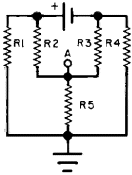 2) The symmetry of the redrawn
circuit suggests that voltage A is at ground potential (or 0 volt). Remove R5 from
the circuit and note that currents flowing through resistor branches R1-R4 and R2-R3
are equal. Hence, the voltages at the midpoint of both branches are equal or point
A is at ground potential. Now insert R5 (which could be any value from zero ohm
to infinity). Since point A is at ground potential, no current will flow through
R5. This can be proved using Kirchhoff's law and setting up three simultaneous equations. 2) The symmetry of the redrawn
circuit suggests that voltage A is at ground potential (or 0 volt). Remove R5 from
the circuit and note that currents flowing through resistor branches R1-R4 and R2-R3
are equal. Hence, the voltages at the midpoint of both branches are equal or point
A is at ground potential. Now insert R5 (which could be any value from zero ohm
to infinity). Since point A is at ground potential, no current will flow through
R5. This can be proved using Kirchhoff's law and setting up three simultaneous equations.
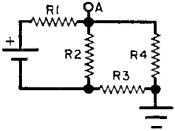 3) The redrawn version of the schematic
is identical to the one shown above in Answer 1 except that the battery is connected
backwards. So, voltage A is the same as in Answer 1 change in sign, or +1.2 volts. 3) The redrawn version of the schematic
is identical to the one shown above in Answer 1 except that the battery is connected
backwards. So, voltage A is the same as in Answer 1 change in sign, or +1.2 volts.
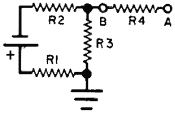 4) Redrawn, the circuit is simplicity
itself. It is easy to determine the current flowing through the loop consisting
of the battery, R1, R2 and R3 (1/3 ampere). The voltage at point B is determined
by the IR drop across R3 (-2 volts) . Since no current flows through resistor R4
to point A, both point A and point B are at the same potential: -2 volts. 4) Redrawn, the circuit is simplicity
itself. It is easy to determine the current flowing through the loop consisting
of the battery, R1, R2 and R3 (1/3 ampere). The voltage at point B is determined
by the IR drop across R3 (-2 volts) . Since no current flows through resistor R4
to point A, both point A and point B are at the same potential: -2 volts.
 5) A glance at the redrawn circuit
suggests that resistors R1, R2, R3 and R5 be combined mathematically into one resistor
(found to be 6 ohms) and, resorting to Ohm's law, the voltage at point A is +3 volts. 5) A glance at the redrawn circuit
suggests that resistors R1, R2, R3 and R5 be combined mathematically into one resistor
(found to be 6 ohms) and, resorting to Ohm's law, the voltage at point A is +3 volts.
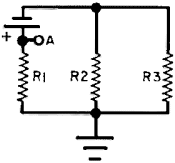 6) The original schematic, impressively
complicated in appearance, becomes straightforward when redrawn as above. It is
simply a problem of combining resistors R2 and R3 mathematically and computing current
flow. Once done, the voltage drop across R1 is computed to be +2 volts. 6) The original schematic, impressively
complicated in appearance, becomes straightforward when redrawn as above. It is
simply a problem of combining resistors R2 and R3 mathematically and computing current
flow. Once done, the voltage drop across R1 is computed to be +2 volts.
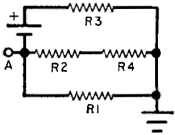 7) Here again it is wise to combine
resistors R1, R2 and R4 mathematically into one resistor and then resort to Ohm's
law. The current through R3 is six-tenths of an ampere. Thus, we find that the voltage
drop across the R1, R2 and R4 resistor combination is +2.4 volts. 7) Here again it is wise to combine
resistors R1, R2 and R4 mathematically into one resistor and then resort to Ohm's
law. The current through R3 is six-tenths of an ampere. Thus, we find that the voltage
drop across the R1, R2 and R4 resistor combination is +2.4 volts.
Posted October 24, 2023
|








